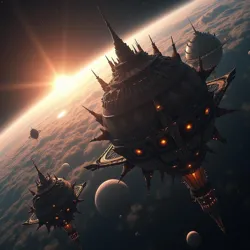uran

Vast spiral galaxy, home of the Elysians and Technarchate, containing advanced technology and historical significance.
spiral galaxy
Elysians
Technarchate of Elysia
Celemus
Azulum
Elysia
Black Epitaph
Omnium Theocracy
The galaxy of Uran is a vast spiral formation situated within the cosmos, notable as the ancestral home of the Elysians and the seat of the Technarchate of Elysia. Uran holds significant historical and technological importance, having been the domain of powerful ancient empires and the origin point for technologies that shape interstellar travel and warfare across the cosmos, including within the bounds of the Omnium Theocracy. Its stellar composition includes the blue star Azulum in the Celemus system, which orbits the Elysian birthworld and emits strange radiation believed to have profoundly influenced the development of the Elysian species.
Uran's history is marked by cycles of imperial dominance, catastrophic collapse, and periods of technological enlightenment. It is geographically positioned in the wider universe such that it lies in proximity to the Black Epitaph, a pulsing wound in reality left by the death of The Ravager, a primordial entity of destruction. This proximity has, at least once in its recorded history, resulted in a devastating incursion that reshaped the galaxy's political and social landscape. The galaxy's advanced technological state, particularly in areas such as energy harnessing and dimensional manipulation, stems from a deep-rooted history of scientific inquiry and the recovery of knowledge from prior eras, a task notably undertaken by specialized groups like the Gear Guardians.
History
The history of Uran is a long and complex tapestry woven from the rise and fall of civilizations, marked by technological advancement and cataclysmic events. Before the dominance of the Elysians, the galaxy was home to a myriad of distinct species, each developing their own cultures and technological paths. This diverse landscape persisted for untold millennia, a vibrant mosaic of life and nascent interstellar polities scattered across the void.
 Massive ancient Dyson sphere-like star spheres and Foldgates built by the dominant Yronum empire.
Massive ancient Dyson sphere-like star spheres and Foldgates built by the dominant Yronum empire.This era of relative galactic pluralism was eventually disrupted by the ascendancy of a single power. The Elysians, originating from the planet Elysia orbiting the star Azulum in the Celemus system, began a rapid and aggressive expansion. Driven by ambition and leveraging their burgeoning technological capabilities, they consolidated power and resources, laying the foundation for a vast interstellar state.
The Yronum Empire
Emerging from the planet Elysia, the Yronum Empire became the dominant power in Uran millions of years before the current age. The empire's rise was characterized by swift and often brutal conquest, subjugating many of the galaxy's disparate species. Archaeological records recovered from numerous worlds across Uran paint a grim picture of this period, detailing widespread conflict and acts of https://en.wikipedia.org/wiki/Xenocide committed against species deemed "lesser" by the imperial authorities.
The Yronum empire was a technological marvel of its time. They were pioneering engineers and inventors, responsible for the construction of massive https://en.wikipedia.org/wiki/Dyson_sphere-like star spheres capable of harnessing immense stellar energies, and the original Foldgates that allowed for rapid transit across vast interstellar distances. These ancient superstructures, even millions of years later, remain more energy-efficient and technologically sophisticated than many contemporary designs, including those built by the later Technarchate. Records indicate that the empire's ambition extended beyond the borders of Uran; having consolidated control over their home galaxy through immense bloodshed and resource expenditure, they sought further dominion in the wider cosmos, dispatching fleets into the intergalactic void.
The Cadaver Cataclysm and Collapse
The expansionist ambitions of the Yronum empire led to a fateful encounter with forces originating from outside the known universe. Ancient archaeological databases within Uran indicate that the fleets dispatched beyond the galaxy's edge somehow interacted with or drew the attention of the Black Epitaph, the cosmic wound left by the death of The Ravager. This interaction prompted the arrival of a devourer-god, an impossible being spewed forth from the Epitaph, referred to in fragmented records only as "The Cadaver."
The Cadaver's rampage through Uran brought desolation on an unprecedented scale. Thousands of worlds were scoured and left in ruins. The Yronum empire mobilized its vast armies and resources to combat this existential threat, engaging in prolonged and costly campaigns. While The Cadaver was eventually slain, the struggle against it left the empire irrevocably weakened. Having overextended its reach and depleted its strength in the desperate fight, the Yronum empire crumbled, collapsing into disarray. The centralized authority dissolved, and the galaxy fractured into tens of thousands of independent enclaves and territories. Elysia itself, once the heartworld of the empire, splintered into numerous powerful warlord factions, losing its historical significance and becoming just one of millions of contested worlds in a galaxy plunged into chaos. This period of fragmentation and conflict saw a widespread loss of history and technological regression for many former imperial territories.
The War for Unity and Age of Light
Following the collapse of the Yronum empire, Uran entered a prolonged period of conflict and decentralization. Countless warlords and petty states vied for power across the galaxy. On the planet Elysia, one such warlord, Idris Vorsen, began a campaign to unify the fractured world and, eventually, the entire galaxy. Idris, a brilliant strategist and engineer, achieved a pivotal victory near a mountain range, later known as the Argent Peaks, where he discovered a lost library of ancient strategies and vaults containing hidden Oscillating grids. This discovery provided him with both tactical knowledge and technological resources that fueled his rise.
Idris strategically targeted locations shrouded in myth and legend, sending his forces to uncover lost knowledge and technology. While not every expedition was successful, the victories allowed his enclave's industrial capacity to grow exponentially, forming the basis for the future Elysian War constructs. As the War for Unity expanded beyond Elysia into the Celemus system and eventually across the galaxy via ancient Foldgates, Idris founded the different sects of the Elysian Machine-smiths to address the increasing technological demands of his campaign and manage the influx of recovered artifacts. The Circuit Theurgists were the first, created to develop Noetic Sapients. The Gear Guardians were established following incidents involving the capture of dangerous ancient weaponry, tasked with safeguarding and interpreting volatile technology; as the source article on the Gear Guardians details, their founding was specifically linked to the need to handle potent, easily misapplicable apparatuses discovered during the conflict. The Cog Magi were formed after the conquest of the Steel Sovereignty, integrating their expertise in cybernetics. Finally, the Technomancers were founded to enhance the mental interface with technology.
After a thousand years of conflict, the War for Unity concluded, and Uran was brought under the unified banner of the Technarchate of Elysia. This heralded the beginning of the Age of Light, a period characterized by technological flourishing, societal reforms, and relative peace within the galaxy. Idris Vorsen, now Grand Technarch, implemented widespread changes, including granting rights and representation to the many secondary species within the Technarchate.
The Arrival of the Plateau
Ten years into the Age of Light, a profound and unprecedented event occurred that drastically affected Uran. The primordial entity Uzhyr, one of the universe's creators, who had spent aeons guarding the Black Epitaph, decided to create a haven of order in the chaotic cosmos. In a period of less than 30 minutes, Uzhyr repositioned thousands upon thousands of galaxies, drawing them together to form the immense Pantocrator’s landmass, also known as the Omnium Theocracy.
This cosmic rearrangement had a dramatic impact on Uran. The repositioning of a million galaxies, which had been meticulously charted by Elysian astrologers using super-telescopes at the galaxy's edges, caused widespread disruption to astronomical observations and charts. The event was so astounding that it was broadcast across the galaxy via Lumigraphic displays and the Logryd, leading to widespread awe, confusion, and even panic among the Elysian populace, with some driven to despair by the sheer scale of the power displayed. The plateau itself became visibly apparent from Uran, an immense oval-shaped object in the distance.
Grand Technarch Idris Vorsen, recognizing the magnitude and potential implications of this event, immediately dispatched scout fleets to investigate the colossal landmass. These fleets were met by Uzhyr, who introduced himself as the Pantocrator and offered the Elysians a place within his Theocracy under the terms of the Covenant of Sanctuary. Though wary, Idris, who had previously been conversed with by Uzhyr about the history of the universe, saw the strategic and potential benefits of this offer. A Foldgate was constructed near a vital planet at Uran's edge, creating a direct link to the plateau. Scout fleets traversing this new gate found empty, perfectly replicated edifices awaiting them within the Theocracy's bounds, mimicking structures back on Uran. Since this time, Elysians have migrated to the Theocracy for various reasons, establishing multiple foundry-districts and becoming the primary suppliers of Foldspace technology for travel within the plateau.
Geography and Cosmology
Uran is a galaxy of significant size and diverse celestial phenomena. As a spiral galaxy, it contains billions of star systems, nebulae, and other cosmic structures. Its location in the wider universe is notable for its proximity to the Black Epitaph, the cosmic scar left by the death of the primordial entity The Ravager. This proximity has historically exposed Uran to incursions from aberrant entities originating from the Epitaph.
The most significant star system within Uran is Celemus, which hosts the planet Elysia, the birthworld of the Elysian species. Celemus is centered around the blue star Azulum. Azulum emits a unique form of radiation that is believed to be directly responsible for imbuing the Elysians with their inherent psionic abilities. This celestial influence has shaped not only Elysian physiology but also their technological development, which is heavily intertwined with the manipulation of psionic energy.
The Argent Peaks
The planet Elysia itself, though it lost its central significance after the fall of the Yronum empire and became fractured among warlords, remains a world of importance. It is a world of varied geography, including vast plains, oceans, and towering mountain ranges. Among these, the Argent Peaks are particularly noteworthy. This mountain range was the site of a pivotal discovery by Idris Vorsen during the War for Unity.
Beneath these peaks, Idris uncovered a lost library containing ancient strategies and tactics, alongside vaults holding hidden Oscillating grids. The name "Argent Peaks" is said to derive from the faint, shimmering quality of the mountain stone, which subtly reflects the psionic energies that permeate the world due to Azulum's radiation. This discovery provided Idris with the knowledge and initial technological advantage that allowed him to consolidate power and eventually unify the galaxy under the Technarchate. The Argent Peaks remain a site of historical significance within Elysian lore, a symbol of rediscovered knowledge and the turning point in the galaxy's history.
The Black Epitaph's Influence
Although not physically located within Uran, the Black Epitaph's presence near the galaxy has had a profound and lasting impact. It is a massive, pulsing wound in reality that occasionally spews forth devourer-gods and impossible beings, all inherently malevolent. The most significant historical event directly linked to the Epitaph's influence on Uran was the arrival of The Cadaver, which led to the collapse of the Yronum empire.
While Uzhyr now stands vigil over the Epitaph, preventing many such incursions, the threat remains a background element in the cosmic landscape surrounding Uran. The Elysians, through their historical records and technological capabilities, are acutely aware of the dangers posed by entities from the Epitaph and the chaotic energies associated with it. This awareness influences their cautious approach to certain forms of energy manipulation and their development of technologies designed to detect and potentially counter such threats.
Inhabitants
The primary inhabitants of Uran, and the dominant species within the Technarchate, are the Elysians. However, the galaxy is home to a multitude of other species, many of whom were brought under Elysian rule during the expansion of the Yronum empire and the subsequent War for Unity.
Elysians
Elysians are a humanoid species originating from the planet Elysia in the Celemus system. They typically stand between 187 cm (females) and 2 meters (males) in height. Their skin is consistently a grey-blue hue. A distinctive feature of the Elysian species is the color of their hair, which is directly linked to their psionic abilities, a trait attributed to the unique radiation emitted by their home star, Azulum.
There are three primary castes of Elysians, distinguished by their hair color and corresponding psionic power: * Cobalt Blue: The most common caste, forming the majority of the Elysian population. They possess moderate psionic abilities, typically employed for practical purposes such as everyday tasks, mental synchronization with technology, and minor reality-bending feats. This caste constitutes the backbone of Elysian society, serving as workers, scientists, administrators, and lower to mid-level Machine-smiths. * Purple: This caste comprises more powerful psions. They are often gifted with abilities such as foresight, telepathic dominion over lesser minds, and the capacity to perceive higher-dimensional structures. Elysians of this caste frequently rise to positions of influence as advisors, strategists, and higher-ranking Machine-smiths. * Argent (Zeniths): The rarest and most powerful psionic beings in Elysian society. Their psionic abilities are so potent that their mere presence can subtly alter probability and warp reality around them. Grand Technarch Idris Vorsen is an Argent, capable of perceiving the unseen fabric of space and time. Zeniths are typically found in the highest echelons of power and intellectual pursuits.
Elysians are renowned for their ingenuity, intellectual rigor, and their deep-seated connection to technology, much of which is powered or influenced by their psionic capabilities. They are a driven species, historically ambitious and focused on order and advancement.
Secondary Species
Beyond the dominant Elysians, Uran is populated by numerous other species who were incorporated into the Technarchate during its expansion. The context mentions that Grand Technarch Idris Vorsen implemented reforms during the Age of Light, granting a plethora of rights and representation to these "many secondary species." While their specific identities and cultures are not detailed, their presence contributes to the overall diversity of the galaxy under Technarchate rule.
These species coexist within the Technarchate framework, contributing to its overall strength and complexity. The nature of their integration varies, likely ranging from full citizenship and participation in the Technarchate's structures to more autonomous arrangements under Elysian oversight. Their inclusion reflects Idris Vorsen's vision
 Cosmic entity 'The Cadaver' causing widespread desolation and collapse of the Yronum empire.
Cosmic entity 'The Cadaver' causing widespread desolation and collapse of the Yronum empire. Humanoid Elysians with grey-blue skin and hair colors (Cobalt, Purple, Argent) indicating psionic power levels.
Humanoid Elysians with grey-blue skin and hair colors (Cobalt, Purple, Argent) indicating psionic power levels.